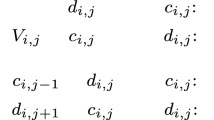Abstract
A stable marriage problem of sizen involvesn men andn women each with a strict preference ordering over all the members of the opposite sex. A solution, called a stable matching, matches the men and women so that no man and woman both prefer each other to their respective partners. The sex-equal stable marriage problem posed by Gusfield and Irving [5] is that of finding a stable matching with the property that the sum of the men’s scores is as close as possible to that of the women’s. This paper shows that the sex-equal stable marriage problem is NP-hard even if each person’s scores coincide with his rankings.
Similar content being viewed by others
References
M. Aigner, Combinatorial Theory. Springer-Verlag, New York, 1979.
C. Blair, Every finite distributive lattice is a set of stable matchings. J. Combin. Theory, Ser. A37 (1984), 353–356.
D. Gale and L. S. Shapley, College admissions and the stability of marriage. Amer. Math. Monthly,69 (1962), 9–15.
M. R. Garey and D. S. Johnson, Computers and Intractability. W. H. Freeman, San Francisco, 1979.
D. Gusfield and R. W. Irving, The Stable Marriage Problem: Structure and Algorithms. MIT Press, Cambridge, MA, 1989.
D. Gusfield, R. W. Irving, P. Leather and M. Saks, Every finite distributive lattice is a set of stable matchings for a small instance. J. Combin. Theory, Ser. A44 (1987), 304–309.
M. Iri, S. Fujishige and T. Ohyama, Graphs, Networks and Matroids. Sangyo-Tosho, Tokyo, 1986. [In Japanese]
R. W. Irving, P. Leather and D. Gusfield, An efficient algorithm for the “optimal” stable marriage. J. Assoc. Comput. Mach.,34 (1987), 532–543.
D. S. Johnson and K. A. Niemi, On knapsacks, partitions, and a new dynamic programming technique for trees. Math. Oper. Res.,8 (1983), 1–14.
A. Kato, On Stable Marriage Problem. Master’s Thesis, the University of Tokyo, 1992.
D. E. Knuth, Mariages Stables. Les Presses de l’Université de Montréal, Montréal, 1976.
E. L. Lawler, Combinatorial Optimization: Networks and Matroids. Holt, Rinehart and Winston, New York, 1976.
A. E. Roth, U. G. Rothblum and J. H. Vande Vate, Stable Matchings, Optimal Assignments and Linear Programming. RUTCOR Research Report #23-90, 1990.
A. E. Roth and M. A. O. Sotomayor, Two-Sided Matching: A Study in Game-Theoretic Modeling and Analysis. Cambridge University Press, 1990.
U. G. Rothblum, Characterization of stable matchings as extreme points of a polytope. Math. Programming,54 (1992), 57–67.
J. H. Vande Vate, Linear programming brings marital bliss. Oper. Res. Lett.,8 (1988), 147–153.
Author information
Authors and Affiliations
About this article
Cite this article
Kato, A. Complexity of the sex-equal stable marriage problem. Japan J. Indust. Appl. Math. 10, 1–19 (1993). https://doi.org/10.1007/BF03167200
Received:
Issue Date:
DOI: https://doi.org/10.1007/BF03167200




